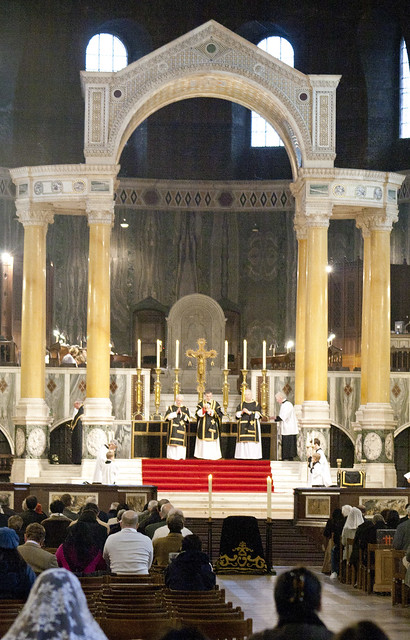 |
| The vast baldachino of Westminster Cathedral, built to frame and emphasise the central rites of the Mass. |
He argues that while it may not be necessary, it does not follow that it is not significant.
First, the adequate expression of our worship requires beauty.
Second, beauty in the liturgy lifts our souls to God.
This post is concerned with the first of these ideas; the second will be expounded in the next post. The first is the less familiar idea of the two, but it is an important one. Public worship is by definition a public act; it must involve words and rites of some kind: it must find some kind of expression, or it is not happening at all. What kind of expression should it have? Something ugly, plain, utilitarian or functionalist? No: Catholic liturgy, like the liturgies of all traditional religions, seeks its expression in the most beautiful fashion possible.
In this way, beauty is appropriate to the liturgy because it is called for by the greatness of the liturgy itself, and the God the liturgy serves. This is sufficient justification. Nothing we can do will be too good, too beautiful, to give expression to our worship.
Here is Dietrich von Hildebrand.
Pp233ff.
Sometimes progressive Catholics claims that those who fight against modern iconoclasm are concerned with the "unessential".
It is indeed not essential that the church in which Holy Mass is celebrated and in which the faithful receive Holy Communion be beautiful. Only the words through which the transubstantiation is accomplished are essential. If this is what is referred to, then one can have no objection. But if by unessential is meant insignificant, if it is meant that such things are the beauty of the church, the Liturgy, and the music are trivial, then this accusation is very wrong, for there is a profound relation between the essence of something and its adequate expression. This is especially true of the Holy Mass.
The way in which this mystery is presented, its visible appearance, plays a definite role and cannot be considered subject to arbitrary change despite the fact that the thing expressed is incomparably more important than its expression. Although the real theme of the Mass is the making present of the mystery of Christ's sacrifice on the Cross and the mystery of the Eucharist, a great weight should nevertheless by put on the sacred atmosphere generated by the words, the activities, the accompanying music, and the church in which it takes place. None of these things can be considered to have a merely aesthetic interest.
In contradistinction to all gnostic denigration of matter and external expression is the specifically Christian principle that spiritual attitudes should also find their adequate expression in the demeanour of our body and our movements and in the style of our words. All the Liturgy is pervaded by this principle. Analogously, the room or building in which solemn and sacred things take place should emanate an atmosphere which corresponds to them. To be sure, the reality of these mysteries is not affected if their expression is inadequate. But there is a specific value in their being given adequate expression.
How wrong it is, therefore, to consider the beauty of the church and of the Liturgy as something that might distract us and draw us away from the real theme of the liturgical mysteries to something superficial! Those who clamour that the church is no museum and that the really pious man is indifferent to these accidentals only show their blindness to the great role played by adequate (and beautiful) expression. Ultimately, this is a blindness to man's nature. Although they claim to be "existential", these persons remain very abstract. They forget that authentic beauty contains a specific message of God which lifts up our souls. As Plato said: "At the sight of beauty, our souls grow wings." [Phaedrus 249d]
Moreover, the sacred beauty connected with the Liturgy never claims to be thematic, as in a work of art; rather, as expression, it has a serving function. Far from obscuring or replacing the religious theme of the Liturgy, it helps it to shine forth.
Value is not synonymous with indispensability. The basic principle of superabundance in all creation and in all culture manifests itself precisely in values that are not indispensable for a certain end or theme. The beauty of nature is not indispensable to the household of nature. Nor is the beauty of architecture indispensable to our lives. But the value of beauty in nature and in architecture is not diminished by the fact that it is a pure gift, superabundantly transcending mere utility.
Thus, beauty has an importance not only when it is the theme (as in a work of art), but also when it has a purely serving function for another theme. To stress that the Liturgy should be beautiful in no way amounts to the colouring of religion with an aesthetic approach. The longing for beauty in the Liturgy simply arises from the sense of the specific value which lies in the adequacy of expression.
The final post in this series will give Hildebrand's final point: the role of beauty in the liturgy in promoting the sanctification of the worshipper.
Support the work of the LMS by becoming an 'Anniversary Supporter'.
Speaking of beauty, that garish red carpet at the Cathedral ought to be removed. It detracts from the liturgical colour to say nothing of what would happen if the sacred species fell on it.
ReplyDelete